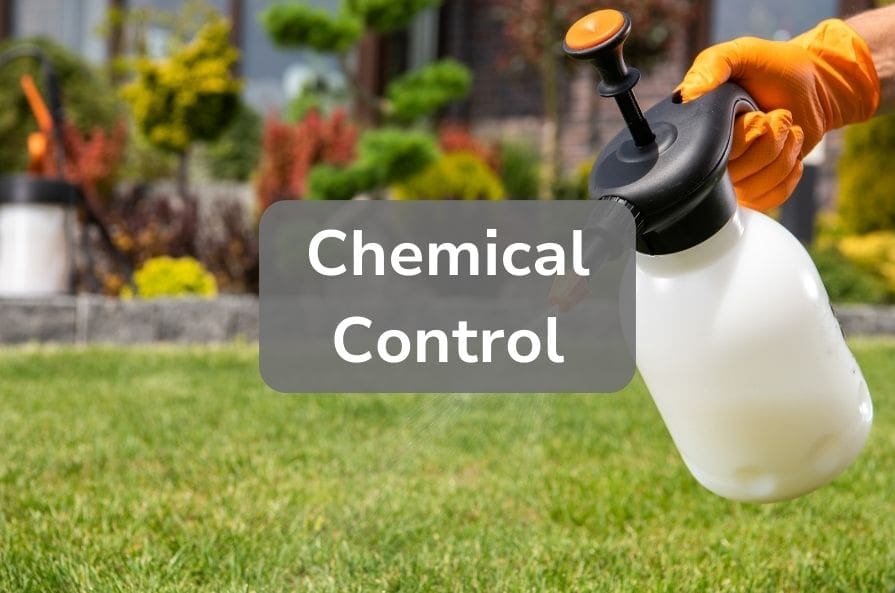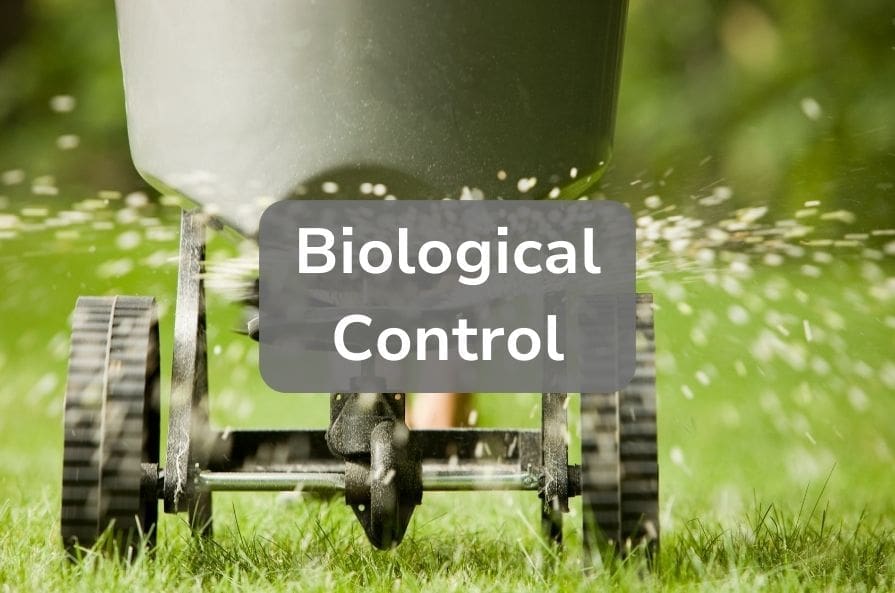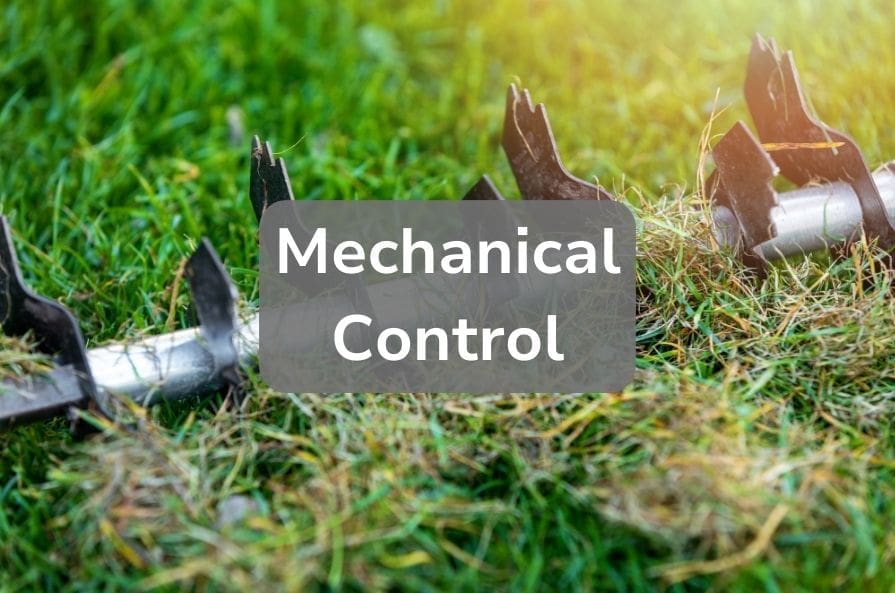Call 01793 625876 or BOOK ONLINE
All About:
Controlling Weeds & Moss in Lawns
Expert Lawn Treatments
Outstanding Results!
Controlling Moss
Managing moss in your lawn is a multifaceted challenge that requires expert attention. Moss is not just a mere garden invader; it’s a symptom of underlying conditions that could be affecting your lawn’s overall health—be it soil acidity, poor drainage, or inadequate sunlight. At Johnson Lawn Care Ltd, we don’t believe in superficial fixes; we delve deep to identify the root causes that facilitate moss growth. Armed with this understanding, we employ one of three meticulously tailored treatment strategies—chemical control, biological control, or mechanical control—depending on your lawn’s specific needs.
Chemical control employs advanced herbicidal solutions, formulated to act decisively against moss while safeguarding your grass. Biological control, on the other hand, utilises environmentally friendly options like Bacillus-based treatments that naturally inhibit moss growth. Mechanical control involves physical processes like scarification to remove moss and improve soil conditions. Our vast expertise in lawn care enables us to select the most suitable approach for your lawn, aimed not merely at eradicating moss but at establishing a resilient, vibrant green space you can take pride in.
Rest assured, with our holistic approach to lawn care, your moss problem is not just treated—it’s comprehensively managed. Trust us to rejuvenate your lawn, utilising the most appropriate method from our extensive toolkit of chemical, biological, and mechanical solutions.
What causes moss to grow in my lawn?
Moss is more than just an unwelcome guest; it's often a sign that your lawn's environment is ideal for its growth. Multiple factors can make your lawn a moss magnet:
- Shade: Moss thrives in areas with reduced sunlight. If large trees or structures overshadow parts of your garden, you might notice more moss there.
- Soil Compaction: Hard, compacted soil can hinder the growth of grass roots and water drainage, creating damp conditions that moss loves.
- Acidity: Moss often prefers acidic soil. If your lawn's pH is on the lower side, it could be more welcoming to moss.
- Excessive Moisture: Moss requires a damp environment. Poor drainage, frequent rains, or overwatering can create persistently wet patches perfect for moss proliferation.
- Weak Grass Growth: Moss isn't typically aggressive. If your grass is thin or unhealthy, moss can take advantage of the void and establish itself.
Understanding these causes is the first step in effective moss management. Once identified, you can take appropriate measures to adjust these conditions, making your lawn less hospitable to moss and more favourable for robust grass growth.
Is moss harmful to my lawn?
While the soft green appearance of moss might seem harmless, its presence can signal various challenges for your lawn's health.
- Moss Isn't Inherently Destructive: Moss doesn't feed on grass or act as a parasite. However, its presence and spread can lead to other indirect issues.
- Indicator of Underlying Issues: Moss often signifies that your lawn's conditions are suboptimal for grass growth. Factors like excess shade, compacted soil, high acidity, or consistent dampness can hinder robust grass development and pave the way for moss.
- Haven for Harmful Insects: Moss can harbour pests that thrive in damp and shaded environments. These insects can, in turn, damage your lawn or become nuisances for garden activities.
- Promotion of Lawn Diseases: The moist conditions moss thrives in can also encourage fungal diseases that affect lawn health. Many lawn diseases favour dark, damp environments, which moss-covered areas often provide.
- Starvation of Grass: If moss is allowed to spread uncontrolled, it forms a thick layer over the soil. This dense moss carpet can prevent sunlight from reaching the grass below and can also restrict the flow of oxygen to the grass roots. Over time, this can weaken or even kill the grass, as it's essentially starved of the light and air it needs to thrive.
- Soil Impact: Moss can further compact soil, making it harder for grass roots to penetrate deeply. It can also exacerbate acidic conditions, which many lawn grasses don't favour.
- Competition for Space: In areas dense with moss, it can outcompete grass for space. Especially if the grass is already thin or unhealthy, moss can dominate, leading to bare patches once it's removed.
In summary, while moss itself isn't the primary villain, its presence and unchecked growth can pave the way for various challenges that compromise lawn health. Addressing the conditions that favour moss and taking preventive measures is key to maintaining a vibrant, healthy lawn.
How can I prevent moss taking over my lawn?
Preventing moss from establishing its dominance is crucial for those seeking a lush, verdant lawn. Implementing these strategies can effectively keep moss at bay:
- Improve Drainage: Regularly aerate your lawn to enhance soil drainage. This will reduce the persistent dampness that moss loves.
- Adjust Lawn's pH: Regularly test your soil's pH. If it's too acidic, consider applying lime to raise the pH, making the environment less hospitable to moss.
- Let in More Light: Prune or thin out overhanging trees and shrubs to allow more sunlight to reach your lawn. More sunlight can discourage moss growth and boost your grass's vigour.
- Regular Lawn Maintenance: Regularly mow, but not too short, and feed your lawn with appropriate fertilisers. A healthy, thick lawn is less susceptible to moss invasion.
- Address Soil Compaction: Along with aeration, consider adding a thin layer of compost or topsoil every year to combat compaction, improve soil texture, and encourage grass growth.
- Choose the Right Grass: Opt for grass varieties suited to your specific lawn conditions. Some grasses are more shade-tolerant or can thrive in different soil types, reducing the spaces moss can exploit.
- Reduce Excessive Watering: If you manually water your lawn, ensure it's done deeply and infrequently rather than shallow and often. Overwatering can lead to conditions favourable for moss.
- Regular Inspections: Periodically check your lawn for early signs of moss. Early detection and intervention can prevent larger infestations.
Remember, the key is to create an environment where grass thrives and moss struggles. With these proactive steps, you can maintain a lawn that's resilient against moss invasions.
What treatments are available to remove moss from my lawn?
Dealing with established moss requires a blend of immediate action and longer-term preventive strategies. In addition to the chemical, biological and mechanical methods detailed below, we also recommend the following:
- Improve Lawn Health: After addressing the moss, we look at the conditions that initially favoured its growth. Undertaking measures like aerating, adjusting the soil pH, enhancing drainage, and applying appropriate fertilisers will help to bolster the grass health and discourage moss.
- Overseeding: Moss removal might leave some patches bare. By overseeding these zones, we encourage swift grass establishment, thwarting the potential return of moss.
- Regular Maintenance: Implement a consistent mowing regimen, water as required, and keep an eye out for moss or other lawn anomalies. An attentively cared-for lawn inherently resists moss incursions.
Why does moss seem to grow faster in certain parts of my lawn?
Moss thrives under specific conditions, often choosing parts of the lawn that best cater to its preferences. The uneven growth of moss across different areas of a garden can be attributed to several factors:
- Shade: Moss loves shaded areas. If parts of your lawn are under trees or the shadows of buildings for extended periods, they are more susceptible to moss invasion. Unlike most grasses, moss doesn't require a lot of sunlight to grow, giving it an advantage in these shaded spots.
- Soil Moisture: Areas of the lawn that have poor drainage or tend to retain water are prime spots for moss. This could be due to compacted soil, the lawn's gradient causing water to pool, or simply an area that gets waterlogged easily after rain.
- Soil pH: Moss prefers acidic soils. If certain patches of your lawn have a lower pH, it becomes a more conducive environment for moss growth compared to more neutral or alkaline parts.
- Grass Vigour: Areas of your lawn where the grass is thin, weak, or unhealthy are more vulnerable. Moss, being opportunistic, will quickly colonise these spots, taking advantage of the reduced competition.
- Traffic: Parts of the lawn with heavy foot traffic can become compacted, leading to poor drainage and weaker grass. Such areas are prime real estate for moss.
- Underlying Issues: Sometimes, issues beneath the surface, like poor-quality soil, remnants of old building materials, or tree roots, can affect grass health and create favourable conditions for moss.
It's essential to observe and understand these variances across your lawn to implement targeted moss control strategies effectively. Addressing the specific reasons for moss growth in different areas will ensure a more comprehensive solution, helping maintain a consistent, lush green lawn throughout.
Will removing moss leave my lawn looking bare?
It's a valid concern that removing moss could leave patches in your lawn that appear empty or barren. While moss removal is crucial for the health of your lawn, it can sometimes result in noticeable bare areas, especially if the moss has significantly overtaken the grass. With our Lawn Renovation Service, we can help your lawn recover to its lush, green appearance, leaving no traces of the moss that once resided there.
- Immediate Aftermath: Right after moss treatment and removal, you may notice that certain areas look sparse. This is particularly likely if the moss issue was extensive.
- Soil Preparation: The next step after moss removal is to prepare the soil for grass re-establishment. This may involve aerating, fertilising, and adjusting the soil's pH levels, creating a welcoming environment for new grass to grow.
- Overseeding or Reseeding: To address the bare spots, we recommend overseeding (applying grass seed over existing grass) or reseeding (planting new grass) these areas with our Premium Lawn Seed Mix. This step not only improves the aesthetic appeal of your lawn but also helps prevent moss or weeds from re-establishing themselves.
- Ongoing Maintenance: A newly seeded area will require regular watering and potentially a lighter fertiliser to help establish the new grass. Once the grass starts to grow, consistent mowing and maintenance will help it blend seamlessly into the rest of the lawn.
The objective is to not just remove the moss but also to encourage the growth and thriving of your lawn grass. With the right post-treatment care, your lawn should soon recover its lush, green appearance, leaving no traces of the moss that once resided there.

Chemical Methods of Moss Control
Chemical Control of Moss
Iron-based treatments are a cornerstone in our arsenal for chemical control of moss. Comprising primarily of iron sulphate, these treatments act quickly and selectively, disrupting the moss’s cellular structure and causing it to desiccate and die, turning it black in the process. This makes it easy to remove the dead moss through raking or scarification, thereby preparing the ground for healthy grass to reclaim its territory. While highly effective and fast-acting, it’s important to note that iron treatments address the symptom, not the underlying cause of moss. For a more holistic approach, we often recommend pairing chemical control with biological or mechanical methods.

Biological Methods of Moss Control
Biological Control of Moss
Biological control presents an eco-friendly method for managing moss, utilising naturally occurring bacteria, specifically strains of Bacillus sp, as its active ingredient. This bacterium consumes the organic matter that moss relies on for growth, effectively starving it without harming the surrounding grass. As the bacteria break down the organic material, they also enrich the soil with nutrients beneficial for grass growth. This dual-action approach not only eliminates moss but also encourages a more resilient, healthier lawn less prone to future moss invasions. Opting for biological control offers a sustainable, environmentally conscious choice that can work in tandem with other moss management techniques for a well-rounded lawn care strategy.

Mechanical Methods of Moss Control
Mechanical Control of Moss - Scarification
Mechanical control provides a hands-on approach to moss management, employing physical techniques like scarification to remove moss and its root system. Scarification not only eliminates the moss but also aerates the soil, enhancing nutrient and water absorption for healthier grass growth. This mechanical action additionally removes the thatch layer, which can harbour moisture and create an environment conducive to moss development. While effective as a standalone treatment, mechanical control often complements chemical or biological methods for a multi-faceted, long-lasting solution.
Controlling Weeds
Addressing weed infestations in your lawn is a task that demands both expertise and precision. Unlike moss, weeds are opportunistic plants that can colonise your lawn, competing with grass for essential nutrients, water, and sunlight. At Johnson Lawn Care Ltd, we go beyond mere weed elimination; we focus on establishing a healthy, balanced lawn where weeds find it hard to gain a foothold. Our treatment protocols involve the use of herbicides tailored to your specific weed problem, whether it’s broadleaf weeds, grassy weeds, or a combination of both.
Herbicides play a pivotal role in our weed management strategy. Formulated to act against specific weed types, these chemical solutions efficiently kill or inhibit the growth of weeds without damaging the grass. Our targeted herbicidal treatments can drastically reduce weed populations, allowing your grass to thrive without competition for nutrients and space.
Like with moss control, our approach to weed management is comprehensive. We combine herbicidal control with other preventative measures, such as proper fertilisation and mowing practices, to ensure that your lawn remains weed-free in the long term. Our holistic methodology encompasses a broad range of techniques, selected to offer you the most durable and effective weed control solutions.
What are herbicides and why are they necessary?
Herbicides, often referred to as weed killers, are specifically formulated compounds designed to control or eliminate unwanted plants, commonly known as weeds. In the context of our gardens, weeds are more than just aesthetic concerns. These persistent plants compete with desired grasses and plants for vital resources such as nutrients, sunlight, and water. Over time, if left unchecked, they can dominate a lawn or garden, leading to an unhealthy and unattractive outdoor space.
While manual methods like hand pulling can be effective for sporadic weed issues, they become less practical and efficient for larger infestations or when dealing with deep-rooted or recurrent weeds. That's where herbicides come in. These treatments provide a more systematic and lasting solution, targeting weeds at various life stages—from seeds waiting to germinate to mature plants.
As licensed professionals, herbicides become a precise tool, which we tailor to the specific needs of your lawn. They ensure that the beauty, health, and vigour of your grass are preserved, while the intrusive weeds are kept at bay.
What type of weeds can be effectively controlled with herbicides?
Weeds are a ubiquitous challenge for gardens across the UK, and our varying climate and diverse soil types offer a fertile ground for a wide range of them. However, thanks to advances in herbicide formulations, we have effective solutions for tackling most, if not all, common lawn weeds.
Some of the frequent culprits include:
- Dandelions: With their bright yellow flowers and deeply rooted structure, they can be tough to remove manually.
- Clover: While some gardeners appreciate clover, others might find it a nuisance as it spreads rapidly across lawns.
- Daisy: A charming flower but often considered a weed when growing amid a lawn.
- Buttercups: Their bright yellow petals might seem appealing, but they can take over damp lawns if left unchecked.
- Plantains: Both broadleaf and buckhorn varieties can become pervasive in gardens.
- Moss: Thriving in damp, shaded areas, moss can quickly spread across lawns, especially during wet winters.
The good news is, that as licensed professionals, we are able to ensure all these weeds, and many others, can be effectively controlled.
How do herbicides differentiate between weeds and my lawn?
It's a marvel of modern gardening science: the ability of certain compounds to discern between the plants we cherish and the weeds we wish to banish. So, how exactly does this work?
Herbicides come in two main categories: selective and non-selective. Selective herbicides are designed to target specific types of plants while leaving others unharmed. Their action is based on the biological differences between weed species and the desired turfgrass. For instance, many common lawn herbicides target broadleaf weeds (like dandelions or clover) without affecting the narrower leaves of typical lawn grasses.
On the other hand, non-selective herbicides are potent and will generally kill or harm any plant they come into contact with. While they're powerful, their use is restricted to situations where total vegetation control is needed, like driveways or paths, and they're applied with utmost precision to avoid harming desired plants.
Our skilled team, equipped with knowledge about the various types of herbicides and their applications, will select the appropriate product for your lawn's needs. By understanding the specific types of weeds present and the type of turfgrass you have, we ensure that the herbicide used is not only effective against the weeds but also gentle on your lawn.
In essence, the discerning action of herbicides comes down to a blend of science, product formulation, and professional expertise. Our commitment is to give you a weed-free lawn, while ensuring the grass you've nurtured remains vibrant and untouched.
How often should herbicides be applied?
The frequency of herbicide application is a balance between ensuring effective weed control and preserving the health of your lawn. It's not a one-size-fits-all answer, as several factors influence the decision.
Typically, lawns benefit from a preventative herbicide treatment in early spring. This targets weed seeds before they have a chance to germinate, offering your lawn a head start in the race for resources. As the growing season progresses, post-emergent herbicides can be applied to tackle any weeds that have managed to establish themselves.
However, the exact frequency will depend on the specific weeds in question, the health of your lawn, the type of herbicide used, and local climate conditions. Some particularly persistent weeds might require a more regular treatment plan, while others might be kept at bay with just an annual or bi-annual application.
We will assess your garden's unique situation and provide a tailored treatment schedule. Regular monitoring and expert insight ensure that herbicide applications are timed optimally, providing maximum weed control while ensuring the safety and vitality of your lawn. The aim is always to use herbicides judiciously, applying them only as often as is genuinely necessary to maintain a lush, weed-free garden.
Will one treatment permanently eliminate the weeds in my lawn?
The quest for a weed-free lawn is an aspiration many gardeners share. While herbicides provide a robust tool in this endeavour, it's essential to set realistic expectations. A single herbicide treatment can significantly reduce the presence of weeds, often to the point where they're scarcely noticeable. However, achieving permanent elimination with just one treatment is unlikely.
Several factors contribute to the re-emergence of weeds:
- Nature of Weeds: Weeds are incredibly resilient. Their seeds can lie dormant for years, waiting for the right conditions to germinate. Others reproduce rapidly, ensuring their continued presence in the environment.
- Environmental Conditions: Changes in weather patterns, especially in the UK with its diverse climate, can create ideal conditions for certain weeds to thrive.
- Soil Health: Compacted, poorly drained, or nutrient-deficient soils can be more susceptible to weeds. Improving soil quality can aid in weed resistance.
- Neighbouring Areas: Even if you've treated your garden, seeds from neighbouring areas can easily blow into your lawn, leading to new growth.
While a single herbicide application can offer a substantial reduction in weeds, ongoing maintenance and periodic treatments are generally necessary to keep them at bay. We will work with you to create a tailored weed management plan, considering the specific weeds in your lawn, your soil type, and other individual factors. This plan will aim to maximise the duration of a weed-free lawn while minimising the need for frequent treatments.
In essence, think of herbicide treatments as part of a broader strategy for a healthy, lush garden. It's not just about removing the weeds, but about fostering an environment where your lawn can thrive and outcompete unwanted invaders.
Will the use of herbicides impact the environment or beneficial insects in my garden?
As RHS trained gardeners and experts in lawn care, we uphold environmental stewardship and ecosystem protection as fundamental principles of responsible gardening. We exercise great caution in implementing any treatment, considering its broader ecological impact, particularly on beneficial insects like bees, ladybirds, and butterflies. Professionally administered, contemporary herbicides are designed to be environmentally conscientious; they decompose over time to minimise lasting soil and water contamination. Furthermore, we meticulously select herbicides that are harmonious with the local ecosystem, aiming to mitigate any negative impact. It's reassuring to note that most lawn-specific herbicides are plant-targeted, posing minimal risk to the vital insect populations that contribute to pollination, natural pest control, and overall ecological equilibrium.
Are herbicides safe for my lawn, pets and family?
Safety is our utmost priority, particularly when administering treatments in spaces where family and pets frequently gather. Rest assured, the licensed herbicides we employ adhere to rigorous UK safety regulations, specifically formulated to target weeds without compromising the health of your lawn or its users.
Following application, we advise keeping children and pets away from the treated area until the herbicide has fully dried. This precaution allows for optimal absorption by the weeds and prevents unintended transfer of the treatment to other areas.
Weed & Feed Vs. Herbicide
Although historically, we have offered the economical option of a combined ‘Weed and Feed’ treatment, we believe the advantages of applying herbicide separately far outweigh the convenience of a mixed solution. By keeping herbicides distinct from fertilisers, we can not only customise each treatment to your lawn’s unique needs but also utilise the highest quality fertilisers available. Furthermore, when taken as part of one of our Annual Lawn Care Programmes, our spring herbicide treatment comes with the added assurance of up to two free re-treatments later in the year, if necessary. This approach aligns with our commitment to delivering not just effective but also environmentally responsible lawn care.
The Difference
Understanding the distinction between herbicides and “weed and feed” treatments is vital for effective and efficient lawn care. While both aim to control weeds, their methodologies and impacts vary significantly.
Herbicides
Herbicides are specialised chemical compounds designed to either kill or inhibit the growth of weeds. They can be selective, targeting specific weeds, or non-selective, affecting all vegetation. As lawn care experts, we apply these solutions meticulously to target the weeds without harming your lawn, ensuring that each application is suited to your lawn’s unique needs.
Weed and Feed
“Weed and feed” products serve a dual purpose: eliminating weeds while simultaneously fertilising the grass. Although convenient, these treatments have limitations. The ratio of herbicide to fertiliser is pre-mixed, which often means you can’t tailor the application to your lawn’s specific requirements. Furthermore, the timing for optimal fertilisation and weed control rarely aligns perfectly, resulting in either less effective weed control or suboptimal fertilisation.
Why We Advocate for Separate Treatments
Our preference for using separate herbicide treatments offers multiple advantages. Firstly, it allows us to customise the herbicide and its application rate precisely to your specific weed challenges. Secondly, separate applications enable us to time the herbicide and fertiliser treatments independently, ensuring each is applied under ideal conditions for maximum efficacy. Lastly, and importantly, decoupling herbicides from fertilisers allows us to use the absolute highest quality fertilisers available. These top-tier products often aren’t compatible with weed and feed formulations, so keeping them separate ensures that your lawn benefits from the best of both worlds.
In summary, while weed and feed products may offer a convenient solution, our approach to separate herbicide and fertiliser applications yields a more precise, effective, and environmentally responsible route to exceptional lawn care.


